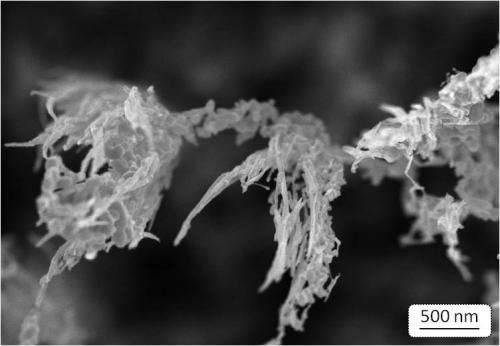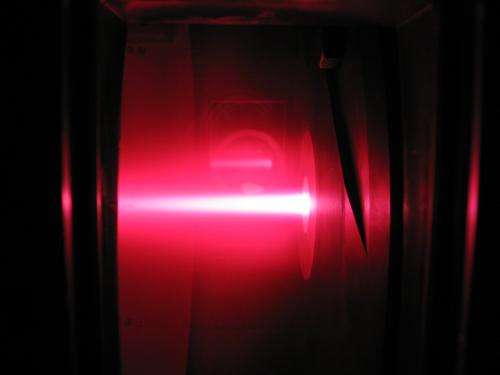Carbon nanostructures grow under extreme particle bombardment

(Phys.org) —Nanostructures, such as graphene and carbon nanotubes, can develop under far extremer plasma conditions than was previously thought. Plasmas (hot, charged gases) are already widely used to produce interesting nanostructures. In the scientific journal Carbon, FOM PhD researcher Kirill Bystrov shows that carbon nanostructures can also develop under far extremer conditions than those normally used for this purpose.
DIFFER's Pilot-PSI device has been built to expose wall materials to plasmas that will rage in future fusion reactors. Such plasmas are 10,000 times more intense than those normally used for the construction of nanomaterials. Using Pilot-PSI, Bystrov's international team demonstrated that this extreme environment provides unexpected possibilities for producing nanostructures.
Out of equilibrium
Plasmas offer major advantages for the controlled production of advanced materials. In the plasma ions and electrons can be brought far out of their thermal equilibria. Under these conditions, the deposition processes can proceed very differently from those at thermal equilibrium. In the widely used technique of plasma-enhanced chemical vapour deposition (PECVD) the plasma density and the quantity of material supplied (carbon) determine which nanostructures develop. The further plasma is from its thermal equilibrium, the more exotic the structures that develop.
Variation

After they had exposed various materials such as tungsten, molybdenum and graphite to a plasma with a carbon supply, Bystrov's team discovered a layer full of exotic carbon nanostructures: multi-walled or extra long nanotubes, cauliflower structures and layers of graphene. Varying parameters such as the plasma density, temperature and composition yielded different structures each time. Bystrov: "It was most surprising that an enormous particle bombardment like that which occurs on the edge of a fusion reactor can yield such delicate structures". The influence of the material on which the deposited structures formed was found to be surprisingly small: on all three of the surfaces tested the same types of structures developed.
Versatile machines

With the research, Bystrov and his colleagues do not yet have a competitor for the PECVD technique. "Our interest is in demonstrating that you can allow interesting processes to occur in environments 10,000 times more intense than you would expect," Bystrov writes in his publication. Research leader dr. Greg De Temmerman from the Plasma Surface Interactions team at DIFFER: "We set up these experiments to investigate what happens with the wall materials in future fusion reactors. This research demonstrates that the conditions in Pilot-PSI and its big brother Magnum-PSI are also interesting far outside the fusion community. These are highly versatile machines."
More information: Spontaneous synthesis of carbon nanowalls, nanotubes and nanotips using high flux density plasmas, Carbon, 28 November 2013. DOI: 10.1016/j.carbon.2013.11.051
Journal information: Carbon





















